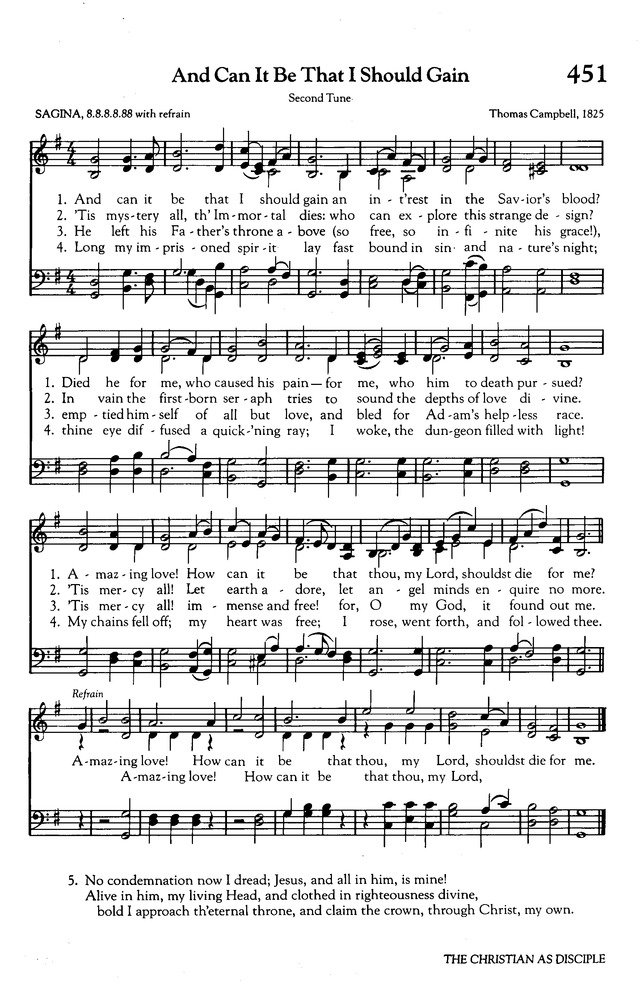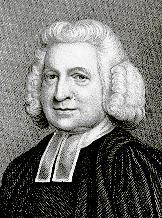And Can It Be That I Should Gain?
By Charles Wesley
Lyrics
An int'rest in the Savior's blood?
Died He for me, who caused His pain?
For me, who Him to death pursued?
Amazing love! how can it be
That Thou, my God, should die for me?
Amazing love! how can it be
That Thou, my God, should die for me!
Who can explore His strange design?
In vain the firstborn seraph tries
To sound the depths of love divine!
'Tis mercy all! let earth adore,
Let angel minds inquire no more.
So free, so infinite His grace;
Emptied Himself of all but love,
And bled for Adam's helpless race;
'Tis mercy all, immense and free;
For, O my God, it found out me.
Fast bound in sin and nature's night;
Thine eye diffused a quick'ning ray,
I woke, the dungeon flamed with light;
My chains fell off, my heart was free;
I rose, went forth and followed Thee.
Jesus, and all in Him is mine!
Alive in Him, my living Head,
And clothed in righteousness divine,
Bold I approach th'eternal throne,
And claim the crown, through Christ my own.
Bible Reference
Romans 5:8
About This Hymn
“And Can It Be That I Should Gain” is one of the most celebrated hymns written by Charles Wesley, a key figure in the Methodist revival of the 18th century. Written shortly after his conversion in 1738, this hymn is a deeply personal and theologically rich expression of amazement at the grace and love of God. It captures the wonder a sinner feels in realizing that Christ’s sacrifice was for him personally. The text is filled with vivid imagery, strong biblical references, and triumphant declarations of faith.
The hymn opens with a rhetorical question that sets the tone of awe and humility: “And can it be that I should gain an interest in the Savior’s blood?” This question reflects the astonishment of a soul newly awakened to the reality of salvation. The following lines describe the sacrificial death of Christ and the unworthiness of the sinner who receives such grace. The phrase “Died He for me, who caused His pain?” is particularly moving, highlighting the paradox of divine love offered to the very ones who offended God.
Charles Wesley’s poetry is full of biblical allusions. The idea of Christ emptying Himself to save mankind recalls Philippians 2:7. The themes of bondage and release, death and life, echo Romans 6 and Ephesians 2. The hymn’s third and fourth verses speak of spiritual captivity and liberation in a dramatic and personal way. The famous line “My chains fell off, my heart was free, I rose, went forth, and followed Thee” illustrates the power of the gospel to transform a sinner from darkness to light.
The tune most commonly associated with this hymn is “Sagina,” composed by Thomas Campbell in the early 19th century. Its bold and energetic melody matches the triumphant tone of Wesley’s words. The rising phrases and strong rhythm help convey the joy and confidence that come from knowing one is saved by grace alone.
In the final stanza, the hymn moves into a tone of complete assurance. It proclaims that the believer no longer faces condemnation and now boldly approaches the throne of God. This reflects the truth of Romans 8:1 and Hebrews 4:16. The final line, “And claim the crown, through Christ my own,” celebrates the eternal reward promised to those who trust in Jesus.
“And Can It Be” remains one of the greatest hymns on salvation by grace. It combines doctrinal depth with emotional power, making it both a theological statement and a heartfelt prayer. For over two centuries, it has inspired worshipers to rejoice in the mercy of God and to stand amazed at the love that gave His Son for us.


📬 Subscribe to Our Devotional Updates
Receive weekly hymns, devotionals, and website features directly in your inbox.
Hymn Information

- Category: Hymn
- Author/Writer: Charles Wesley (1738)
- Added: July 22, 2025
- Last Updated: July 22, 2025
- Views: 886
MIDI File
Recent Blog Posts
-
 How to Develop a Consistent Prayer Schedule
How to Develop a Consistent Prayer Schedule
Dec 11, 2025 -
 How to Forgive Someone Who Deeply Hurt You
How to Forgive Someone Who Deeply Hurt You
Dec 11, 2025 -

-
 Why Christmas Is Celebrated on December 25
Why Christmas Is Celebrated on December 25
Dec 11, 2025 -
 10 Most Renowned Hymn Writers
10 Most Renowned Hymn Writers
Dec 10, 2025
Visit Us on Social Media
Latest from X (Twitter)
Tweets by HymnalLibraryLatest from Facebook
Latest on YouTube
Daily Bible Verse
Disclaimer
The hymns, sheet music, MIDI files, and related content on this website are provided for educational and research purposes only.
- Public Domain: Many of the hymns featured here are in the public domain and may be freely used.
- Copyrighted Works: Some hymns may still be under copyright protection. Where applicable, permission has either been requested from the copyright owner, or the content is shared under the principles of fair use for educational purposes.
⚠️ Important Notice: If you wish to reproduce, distribute, or use any copyrighted hymn beyond personal study or educational use, you must obtain permission directly from the copyright holder. This website does not grant any rights for commercial use yet.
If there is any other question please address it to us in our Contact Page, for further assistance. Thank you for using the site. May God Bless You.